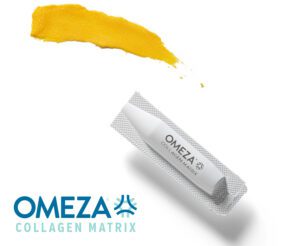Omeza, a skin science company, announced today the U.S. Food and Drug Administration (FDA) cleared Omeza® Collagen Matrix through the FDA 510(k) premarket notification process. Omeza® Collagen Matrix is Omeza’s first Rx product, and the first drug/device combination matrix of its kind for chronic wound care.
“No one is taking on the challenge of making advanced wound care products both effective and affordable, yet preventable amputations are on the rise. We are determined to bridge that gap,” said Sarah Kitlowski, President of Omeza. “Our mission is to give practitioners groundbreaking new tools to help protect and manage the wound during the natural processes of wound closure.”
Omeza® Collagen Matrix (OCM) is a wound care matrix comprised of hydrolyzed fish collagen infused with cod liver oil, which acts as an anhydrous skin protectant, and other plant-derived oils and waxes. When applied to a wound surface, the matrix is naturally incorporated into the wound over time. Omeza® Collagen Matrix is designed for intimate contact with both regular and irregular wound beds to provide a conducive environment for the patient’s natural wound healing process.
The product features a no-prep application supplied in easy to use, unit dose vials.

Omeza® Collagen Matrix is indicated for the management of wounds including partial and full-thickness wounds, pressure ulcers, venous ulcers, diabetic ulcers, chronic vascular ulcers, tunneled/undermined wounds, surgical wounds (donor sites/grafts, post-Moh’s surgery, post-laser surgery, podiatric, wound dehiscence), trauma wounds (abrasions, lacerations, superficial partial thickness burns, skin tears) and draining wounds.
In the United States, chronic ulcers are conservatively estimated to cost health care systems $28 billion each year as a primary diagnosis and $31.7 billion as a secondary diagnosis. According to the American Diabetes Association (ADA), over 9–12 million Americans suffer from chronic ulcers. The mortality rate for leg ulcers after the first amputation has dramatically doubled from 20% to 50% in the first 3 years to 70% after 5 years. *
- Human Wounds and Its Burden: An Updated Compendium of Estimates, by Chandan K. Sen, https://www.ncbi.nlm.nih.gov/

